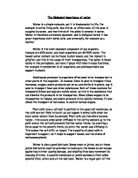The Biological Importance of Water
Water is essential to life itself, with out water life on earth would not exist. Water is a major component of cells, typically forming between 70 and 95% of the mass of the cell. This means that we are made from approximately 80% water by mass. Water also provides an environment for organisms to live in as 75% of the earth is covered in water.
Water itself is a simple molecule made up of 2 hydrogen atoms and one oxygen atom - H20. The hydrogen and oxygen atoms are bonded covalently. Covalent bonds are formed by sharing electrons in the outer orbits of the quantum shells. In the case of water however the large number of protons in the oxygen nucleus have a stronger attraction for these shared electrons than the comparatively tiny hydrogen nuclei. This pulls the electrons slightly closer to the oxygen nucleus and away from the hydrogen so that the oxygen develops a slight negative charge and the hydrogen's a slight positive charge. This makes the molecules slightly polar.
This slight charge means that when water molecules are close together the positively charged hydrogen atoms are attracted to the negatively charged oxygen atoms of another water molecule to form a weak hydrogen bond.
The bonds are weak individually but the great number of them means that the total force keeping the molecules together is considerable.
Water is an unusual substance, mostly due to it's hydrogen bonds, it's properties allow it to act as a solvent, a reactant, as a part of the environment and as a temperature stabiliser.
Water can dissolve polar or ionic substances and can keep them in solution because of water's own polar properties. Substances that dissolve in water are know as hydrophilic substances. Ionic substances such as sodium chloride, NaCl, are made up of positive and negative ions. Sodium chloride is held in it's structure by the strong attraction between it's positive sodium ions and negative chloride ions. Normally these ionic attractions require a large amount of energy to break but when put into water the negative oxygen side of the water molecules cluster around the positive sodium ions Na+ and the positive hydrogen atoms cluster around the negative chloride ions Cl-. The attraction between the Na+ and Cl- ions is weakened as the ions are separated.
Water's properties as a solvent are vital to life as most biochemical reactions such as respiration occur in solution. This is why cell cytoplasms contains about 90% water. Water cannot dissolve hydrophobic substances such as fats and oils. These are used by organisms as cell membranes to separate cells and also as waterproofing as they prevent water from entering the organism if it is covered in a hydrophobic substance. Often in living organisms, substances must be solution, and water is the solvent which makes this a possibility. For example, plants can only obtain mineral salts in solution, and human digestion will only dissolve soluble foods, so large starch molecules must be broken down in soluble sugars, such as glucose.
The crucial reactions of metabolism take place in the protoplasm with the materials in solution. Waste products can also be removed in solution, for example in urine.







